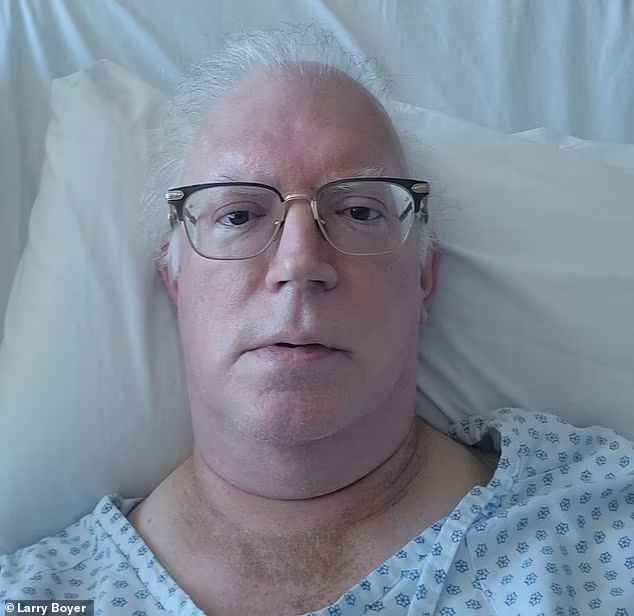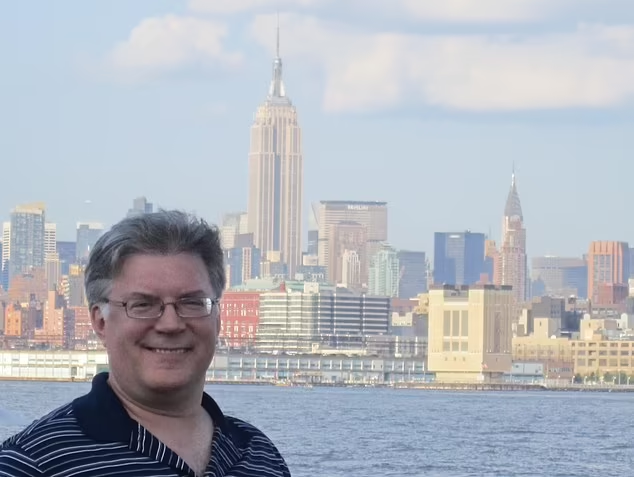 Larry Boyer was told he had just six months to live after being diagnosed with stage four pancreatic cancer.
Larry Boyer was told he had just six months to live after being diagnosed with stage four pancreatic cancer.
Not only is this type of cancer one of the world’s deadliest — just three percent of patients survive it — the initial tumor had spread to other organs and triggered the growth of 16 additional tumors.
As a retired data scientist, he knew the odds were against him.
But 18 months later, the father-of-two from Connecticut is alive and, miraculously, cancer-free.
Mr Boyer, 56, achieved remission thanks to an experimental therapy that involved freezing his tumors to death and injecting cancer-clearing cells directly into them.
Mr Boyes said: ‘When I was initially diagnosed in May 2022, I was given one year to live with standard of care treatment alone, [or six months with no treatment].
‘[But] the combination of my treatment… with my standard of care chemo treatment has brought me the best possible results.
‘A year later I have no sign of cancer in my blood work or on scans.’
Mr Boyes said: ‘When I was initially diagnosed in May 2022, I was given one year to live with standard of care treatment alone, [or six months with no treatment].
‘[But] the combination of my treatment… with my standard of care chemo treatment has brought me the best possible results.
‘A year later I have no sign of cancer in my blood work or on scans.’
The two-pronged approach involves freezing the tumors via a procedure known as cryoablation, cryosurgery or cryotherapy.
Doctors insert a small metal probe through the skin and into the tumor where extremely cold gasses are released directly into the mass to kill its cells.
The second step uses intratumoral immunotherapy, in which drugs are injected directly into a tumor to trigger an immune response.
The treatment uses two drugs; Yervoy, which stimulates white blood cells to attack the cancer, and Opdivo, which helps immune cells to recognize and destroy cancer cells.
Exciting early studies shows the therapy can treat people for whom surgery is not an option because the cancer has grown so out of control.

CANCER-FREE: The father-of-two from Connecticut is still here and now in remission
Medical doctor and radiologist Jason Williams is a pioneer in this emerging field and has been using the approach at his clinics in the US for years.
‘We have to help people because they’re dying,’ Williams told the Hartford Courant. ‘I see we’re going to be the ones to cure cancer.’
His novel approach, known as ‘intratumoral Immunotherapy with PEF (or Pulsed Electric Field) and cryoablation’, is legal in the US.
But it has not been approved to treat pancreatic cancer specifically, which makes access patchy and incredibly expensive because it’s not covered by insurance.
Mr Boyer traveled to Williams’ clinic in Cabo San Lucas, in the Mexican state of Baja California where the procedures cost a tenth of the price in the US.
He has still paid more than $125,000 out-of-pocket for the procedures.
Mr Boyer received the treatment schedule three times a week for three weeks on three separate occasions, with chemotherapy in between each.
He had the first round in late September and a month later doctors said Mr Boyer’s liver tumor was ‘liquefying’.
By early November, scans showed the large tumor in his liver had shrunk by 50 percent and the large tumor on his pancreas had reduced in size by 65 percent.
It was also revealed that 13 half-inch tumors in his liver had disappeared along with another larger mass.
Recent scans have not detected any cancerous cells in his body, meaning he is currently in remission.
He will not be declared cured and cancer free until he has five years of negative test results.
In a post online on the two-year anniversary of his diagnosis: ‘I am reminded nearly every day how fortunate I am as people I’ve talked to pass away.
‘Just yesterday someone who went to Dr Williams soon after I did ended up deciding to call it quits.
‘I’m grateful for another year and for all the support that everyone has given me.’
Pancreatic cancer is one of the deadliest in the US because it normally doesn’t cause symptoms until the later stages.
This means it is not normally diagnosed until it is stage four, when the five-year survival rate drops to about three percent.
Pancreatic cancer is the tenth most common cancer in the US, with about 66,000 Americans diagnosed with the disease.
Written by Luke Andrews for The Daily Mail ~ October 15, 2024
